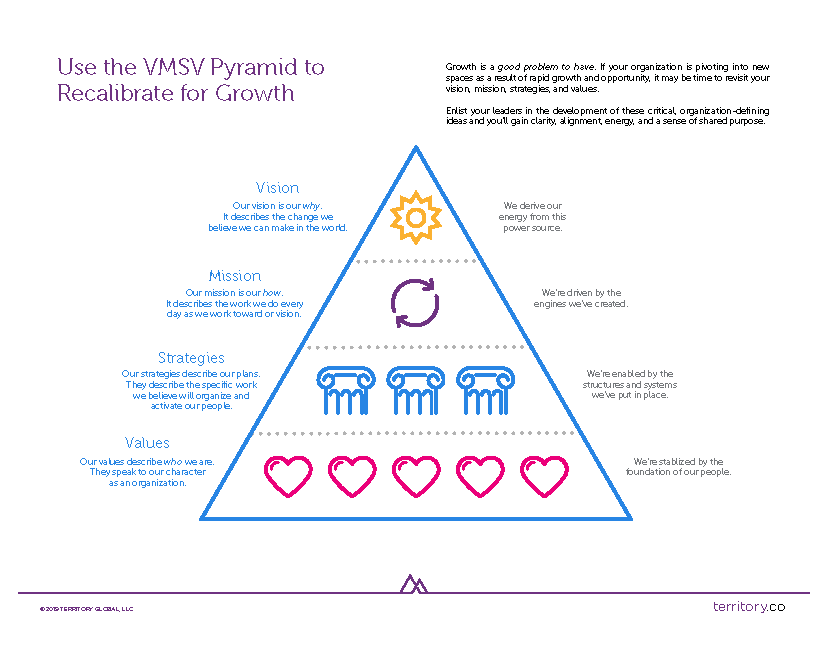Recalibrate for growth
Upgrade your mission, vision, values, and strategy
Wednesday, October 16, 2019
Recently a young company approached us to help them align their leadership team on their vision, mission, and values. They were suffering from a great problem to have: they were growing at an outrageous pace. They were still young enough—and small enough—that they had flexed in order to provide new offerings as opportunities arose.
This kind of agility, coupled with rapid growth, was the perfect recipe for mission and vision creep—one day an organization’s core work is X, and six months later, it’s X, Y, and Z. Again, though, this is a great problem to have; instead of closing down new opportunities, the leadership team recognized that it was imperative to realign their vision, mission, values, and strategy to reflect the changed character of the organization. We scheduled a two-day design thinking intensive as part of a several-day leadership retreat.
Download the VMSV Pyramid

Our definitions
So what do we mean when we say “vision,” “mission,” “values,” and “strategy”? First, it’s important to acknowledge that there is no one master definition for any of these terms. We like to say that frameworks are there to serve you, not to be served by you. There are globally-successful companies who use a combined vision and mission statement. Others never express their values to the outside world. But by and large, there is deep and rich value in using this standard framework to help define where your company is headed, how you plan to get there, and who you will be as you do it.
Here’s a quick set of definitions that we follow:
Vision
Your vision is a description of how the future world will be different because of the work your organization does. A vision statement usually describes a moment five to twenty years in the future. Sometimes, particularly for a not-for-profit organization, a described vision may be profoundly aspirational, though it should never be so “pie-in-the-sky” that your team cannot imagine it ever coming to fruition. Oxfam, for example, simply says, “our vision is a just world without poverty.” A vision is also often called a “magnetic north” or a “north star” because it defines a common goal—or direction—for your team.
A vision allows your team to ask themselves, “will this help us to get to our shared goal?”
Mission
Your mission is a description of the core work you do, every day, in your organization in order to achieve your vision. A mission statement describes the work that makes you who you are. A mission statement is not a strategy; its altitude should be dialed in correctly so that it can encompass the breadth of work your team does and not unnaturally limit opportunities for new kinds of offerings. A mission statement—like any of these components—can and should be revisited as necessary.
A mission allows your team to ask themselves, “is this the work we do?”
Values
Your values describe the way you go about the work you do. Values speak to the character of your organization. We sometimes refer to them as “guardrails.” Values are powerful; in the best cases, values remain consistent even as mission and vision statements change. At Territory, for example, we follow five core principles that affect every aspect of our work, whether working with clients, partners, or among ourselves. No matter the project, no matter its size or scope, we always focus on people, work visually, collaborate and co-create, evolve and improve, and mind the system.
Values allow your team to ask themselves, “is this who we are?”
Strategy
A strategy is significantly shorter-term than any of the previous three items, but it’s worth considering in contrast to a vision, mission, and values. Strategy defines the way—usually in the shorter-term—you will go about doing your mission in order to achieve your vision. Strategy usually defines short- and long-term goals and also describes how an organization will accomplish those goals.
Download the VMSV Pyramid

Co-creation creates co-ownership, alignment, and a shared sense of purpose
The start-up we were working with numbers over 100 employees, spread throughout the world. Of course, the leadership team had grown along with the number of employees and the amount of work. The old company mission and vision were created when the leadership numbered two; we were meeting with ten thoughtful, experienced, and wise leaders.
Fortunately, as an organization grows, a perfect opportunity usually arises to revisit vision, mission, and values with your leadership team. It seems obvious, but it’s also worth saying, that the people who work side-by-side to solidify your company’s core principles feel a deep sense of ownership of those principles. This is not to say that a new leader cannot be “read into” your company’s culture and principles—but it is far preferable to co-develop when you can.
Ownership is important, but the other side-effect of participating in meaningful, inclusive, and productive dialogue (which we create using Design Thinking principles) with your team is that it bonds your team together. A good design thinking session creates clarity—often where a team believed they already had clarity but they actually didn’t. Design thinking also connects people together in the way that co-creation always does . . . everyone feels ownership in the work but they also easily recognize that the rest of the team also owns the work. And perhaps most importantly, good design thinking creates alignment; even if you cannot agree on everything, you can commit to the current path forward.
You are probably aligned more than you think
Speaking of alignment, our work is often about surfacing hidden alignment as much as creating alignment where there is none. This makes sense: your team members toil away daily at their small piece of the larger puzzle that is your organization’s work. It is easy—even understandable—that a person in this position can start to feel like they are the only person on a team who feels the way they do. Often, small bits of communication are interpreted to imply a much larger disconnect between one team member or another. We are almost never surprised during a design session—but over and over again we hear clients say, “I’m surprised at how aligned we are!” Especially when building big-picture tools like a vision, mission, and values, it’s rare to find a team that isn’t mostly aligned.
“Mostly” is doing a lot of work in that last sentence, and for good reason. One of the most significant benefits of spending a few days getting aligned as a team is the unearthing of the few—but often disabling—ways your team is not aligned. Unearthing those places where you don’t agree allows the team to collaborate on finding solutions. Discovering how aligned you already are is powerful; it’s always exciting to be able to say, “you all feel that way, too? I’m not alone in this?” But there is even more energy and momentum to be found when you can co-create a solution to the disagreements you actually have.
The power of facilitation
Territory is expert at designing and facilitating meetings that produce results. A group of strong leaders can be a challenge to manage, and the right goals, activities, and empathetic facilitation can make all the difference. We would be delighted to talk with you about how we can help your team move forward with clarity, alignment, and renewed purpose. And we know how to make that work engaging, meaningful, and a lot of fun.




